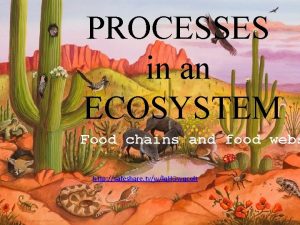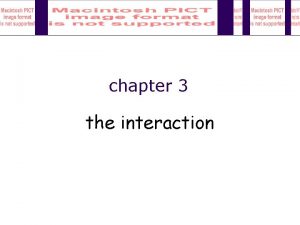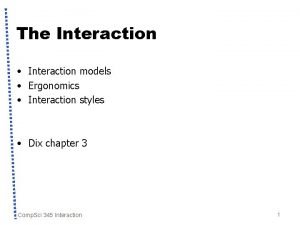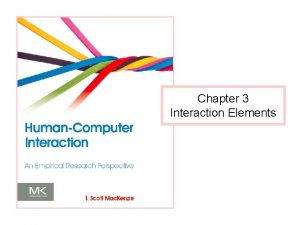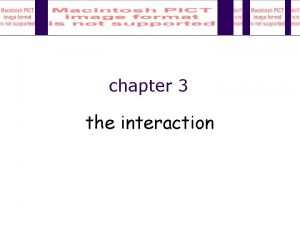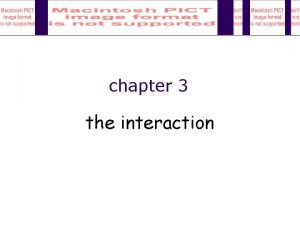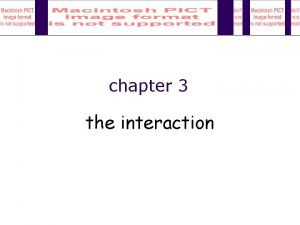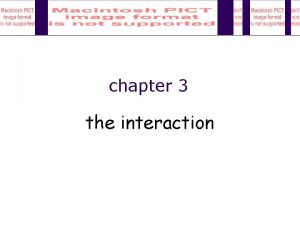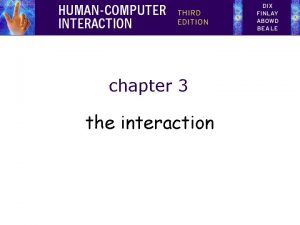Exploring the interaction of ecosystem processes and ecosystem






















- Slides: 22

Exploring the interaction of ecosystem processes and ecosystem services for effective decision-making Alistair Mc. Vittie & Ioanna Siameti

Acknowledgements • Funded by NERC Valuing Nature Network with support from the Scottish Government’s Strategic Research Programme • Project team: SRUC: • Alistair Mc. Vittie, Klaus Glenk, Ioanna Siameti James Hutton Institute: • Julia Martin-Ortega, Wendy Kenyon, Matt Aitkenhead, Inge Alders, Rupert Hough, Helaina Black Centre for Ecology and Hydrology: • Lisa Norton, Simon Smart, Francois Edwards, Mike Dunbar 2

Content • • • Motivation for study Identifying ecosystem interactions Developing an interdisciplinary model Scenario results Next steps Summary 3

Motivation • Ecosystem services concept is increasingly being used as a framework for science and policy • A lot has been done to conceptualise the use of ES, but more required to operationalize ES for decision making • Need for interdisciplinary working • Better understanding of the links between ecosystem processes, services and benefits 4

MEA framework 5

Ecosystem service cascade Haynes-Young and Potschin, 2009 6

UK NEA framework 7

Identifying ecosystem interactions • Workshop of researchers and policy makers • Aim was to identify linkages between – Ecosystem processes; – Management interventions; and – Four desired outcomes (ecosystem services): • • Sustainable crop yield Increased biodiversity Improved water quality Reduced flood damage 8

Identifying ecosystem interactions 9

Identifying ecosystem interactions Attercap network analysis – Matt Aitkenhead, James Hutton Inst 10

Water quality mapping example Attercap network analysis – Matt Aitkenhead, James Hutton Inst 11

Developing an interdisciplinary model • Even a single policy objective resulted in complex set of interactions • Needed to simplify the model or identify the key components • Needed an approach that was accessible to all team members • Decided to use Bayesian Belief Networks 12

What is a BBN? Flood risk High Medium Low Rainfall High Low Slope High Low High 100 20 20 0 Surface flow Medium 0 60 20 0 Proximity Near Far Welfare impact -100 -20 -60 -10 -20 0 Low 0 20 60 100 13

Developing a BBN States of nature Terrestrial processes Management intervention Aquatic processes Final ecosystem services Values 14

Utility values Flood risk Water quality Utility Low Blue (high) 100 Low Green (good) 100 Low Yellow (moderate) 75 Low Red (poor) 50 Medium Blue 65 Medium Green 65 Medium Yellow 50 Medium Red 35 High Blue 50 High Green 50 High Yellow 25 High Red 0 15

Example scenarios Scenario Region Land use Soil type Slope A East England Arable Light free draining (sandy) Low B West England Grassland Heavy poorly draining (clay) Medium C West England Grassland Heavy poorly draining (clay) High 16

Model results: ‘utility’ values ‘Utility’ gain Scenario No buffer strips Buffer strip management Grass Natural Vegetation Mixed A 55. 39 56. 71 59. 37 58. 04 B 55. 61 58. 23 59. 91 59. 07 C 54. 53 57. 42 59. 25 58. 33 5 4 3. 5 3 2. 5 2 1. 5 1 0. 5 0 Grass Natural Vegetation Mixed A B Scenario C 17

Changes in outcome probabilities Scenario A Flood risk Water quality Low Medium High Blue Green Yellow Red Status quo (%) 28. 6 48. 6 22. 8 22. 2 31. 6 28. 5 17. 6 Grass (%) 35. 2 46. 8 18. 0 25. 1 32. 2 27. 0 15. 7 Change in pr 6. 6 -1. 8 -4. 8 2. 9 0. 6 -1. 5 -1. 9 18

Expanding the BBN States of nature Terrestrial processes Management intervention Aquatic processes Final ecosystem services Preferences Values 19

Combing different models Land management Cost Land cover Nutrient load model (PLANET) Lake nutrient status Weather Algal production model (PROTECH) Runoff model (GWLF) Water quality Buffer strips Presence/ absence Wild species diversity Location Extent Landscape amenity Species Climate regulation Vegetation cover Carbon storage 20

Benefits of the approach • Provides an opportunity to develop joint knowledge and understanding of the system • Diagrammatic allows easily visualisation of the system • Doesn’t require precise knowledge of biophysical or socioeconomic relationships • Can combine both quantitative and qualitative information • Degree of complexity can be kept to reasonable level – due to types of data used; and – working back from outcomes of interest • BBN software is relatively easy to operate 21

Issues • Do ‘utility’ values need to be linked to actual values, or are weights sufficient? • Probabilistic outcomes may reflect inherent uncertainty in ecosystems, but: – How do we apportion values across outcomes (e. g. benefit transfer)? – How do we account for uncertainty in both outcomes and values? – Are there important thresholds for preferences? • How, or can, we integrate values across multiple services? • Statistical measures such as confidence intervals desirable • Risks becoming a ‘black box’ in decision making – Need for stakeholder involvement in model building? 22
 Concurrent in os
Concurrent in os Hình ảnh bộ gõ cơ thể búng tay
Hình ảnh bộ gõ cơ thể búng tay Ng-html
Ng-html Bổ thể
Bổ thể Tỉ lệ cơ thể trẻ em
Tỉ lệ cơ thể trẻ em Gấu đi như thế nào
Gấu đi như thế nào Tư thế worms-breton
Tư thế worms-breton Hát lên người ơi
Hát lên người ơi Các môn thể thao bắt đầu bằng tiếng chạy
Các môn thể thao bắt đầu bằng tiếng chạy Thế nào là hệ số cao nhất
Thế nào là hệ số cao nhất Các châu lục và đại dương trên thế giới
Các châu lục và đại dương trên thế giới Công thức tính thế năng
Công thức tính thế năng Trời xanh đây là của chúng ta thể thơ
Trời xanh đây là của chúng ta thể thơ Cách giải mật thư tọa độ
Cách giải mật thư tọa độ Làm thế nào để 102-1=99
Làm thế nào để 102-1=99 Phản ứng thế ankan
Phản ứng thế ankan Các châu lục và đại dương trên thế giới
Các châu lục và đại dương trên thế giới Thơ thất ngôn tứ tuyệt đường luật
Thơ thất ngôn tứ tuyệt đường luật Quá trình desamine hóa có thể tạo ra
Quá trình desamine hóa có thể tạo ra Một số thể thơ truyền thống
Một số thể thơ truyền thống Bàn tay mà dây bẩn
Bàn tay mà dây bẩn Vẽ hình chiếu vuông góc của vật thể sau
Vẽ hình chiếu vuông góc của vật thể sau Nguyên nhân của sự mỏi cơ sinh 8
Nguyên nhân của sự mỏi cơ sinh 8
























